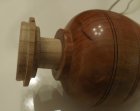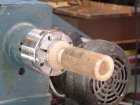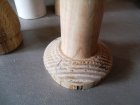Hey folks I was hoping I could pick your brains in regard to chucks for wood lathes.
I have a Jet JWL-1236 lathe. It has a 1"-8 spindle nose.
Mostly I have used this lathe for turning small model rocket components like nose cones, transitions, centering rings etc. I've also turned some goblets, candle holders and a grog mug. See below for some photo's.
Most of the components I have turned thus far I have made from pine.
The biggest issue I am having is keeping the bore and o.d. of the parts concentric. Turning with the face plate just isn't accurate enough.
What chuck would you recommend?
Thanks in advance!
I have a Jet JWL-1236 lathe. It has a 1"-8 spindle nose.
Mostly I have used this lathe for turning small model rocket components like nose cones, transitions, centering rings etc. I've also turned some goblets, candle holders and a grog mug. See below for some photo's.
Most of the components I have turned thus far I have made from pine.
The biggest issue I am having is keeping the bore and o.d. of the parts concentric. Turning with the face plate just isn't accurate enough.
What chuck would you recommend?
Thanks in advance!











































